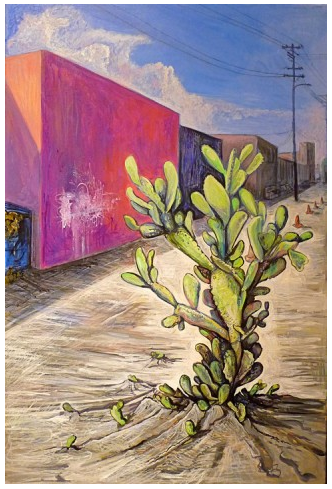[youtube http://www.youtube.com/watch?v=N3ilElOoQQM]
Painfully, I’ll admit that writing a blog about Alice Bag’s Violence Girl has taken longer than reading the memoir itself. I was unsure how to approach it. In both the beginning and the end of the book, the influence of Chicano culture is obvious. Alice Bag, born Alicia Armendariz, grew up in an ethnic East Los Angeles neighborhood, the daughter of a Mexican father and a Mexican-American mother. At the end of her memoir, she returns to East LA to teach kindergarten, realizing that no one can gear lesson plans to immigrants and children of immigrants like a person who has shared their experience. But what about the bulk of the book? The large middle section, during which Alice lived in Hollywood and was a major player in the emerging punk scene of the late 1970s? Even after reading Violence Girl, my brain still conjured up the image of punk rock as predominantly white and male. Even though Alice’s book is full to the brim with strong, empowered women of the punk movement, to me they embodied a feminism that was distinctly Anglo and middle class. I finally realized, however, that it was Alice’s poor, Chicano background that made her such a powerful force in the rebellious uprising of punk.
Alice grew up in a fairly typical Chicano household. Her father did freelance construction work and her mother’s main responsibilities were to cook and clean. Her mother, she remembers, never ate with her and her father at the table. She stayed in the kitchen, eating only when the food was done and everyone else was served. Her father was domineering, and ultimately quite violent. Over any small signs of disrespect from her mother, he would beat her within an inch of her life. From quite early on, growing up in this environment of extreme gender inequality, Alice decided that she would never grow up to live the kind of life her mother did. Her father was the embodiment of exaggerated machismo and her mother fits perfectly in line with the Chicano Nationalist image of a woman who endures hardships for the sake of her domestic life. Alice, in unknowing agreement with so many Chicana feminists, saw the problems inherent in this rigid definition of family life.
While beginning to formulate thoughts about Chicana oppression as a child in her own home, Alice was also beginning to understand Chicano oppression on a larger scale outside her home. The only language spoken in her house was Spanish. When Alice started going to school, though she was definitely not stupid, she was treated as such by unsympathetic teachers who were too lazy to help her overcome her language barrier. If teachers are unwilling to help their students at such a young age, then students are left developmentally behind. This handicap follows them throughout their school career, making college or white collar jobs a nearly impossible dream. This is one of the many ways that Chicanos in America are kept down, and Alice’s realization of this lead to her later decision to be a teacher herself. While still fairly young, Alice recalls seeing the young men and women of the Brown Berets protesting the Vietnam War. She also recalls how quickly the peaceful protest turned into a horrifying scene of racially charged police brutality.
Like many art forms when they first emerge, punk was a challenge to the status quo. It was youths that had always been outcasts, coming together to create a culture in which they no longer felt like outcasts. There is, and always has been, and undercurrent of anger in punk. Looking back on it, how can one not see that Alice Bag was the perfect punk candidate? As she learned at the war protest, to be Chicano is to inherently challenge the status quo. She would see that kind of police brutality mirrored at what were supposed to be peaceful (albeit chaotic) punk shows. In these instances, Alice could understand better than most that to be outside of the dominant group is to be a target that society wants to subdue. As one who, so young, learned the price women can pay for their subordination, her anger and her need for catharsis and her to establish a presence of strength made her a dynamic and forceful punk lead singer.
As a teenager, living in Hollywood to be close to the music scene she was entrenched in, she began to see her friends lives wrecked because of drugs. Between heroin and loneliness, she saw people that loved take their lives and have their lives taken. Without a doubt, I think it was her culture that spared her. Among so many things that can be viewed in the Chicano family structure as negative, the overriding positive is the notion that family is important. In one way or another, everyone in the family has a responsibility to each other. Her father provided for her, her mother fed her, and she loathed the idea of ever letting them down. They wanted her to have a better life, to rise above generations before her. She could see that a lot of the paths her friends were winding up on were not paths that her parents would want her on, and ultimately were not paths that she herself would want to be on. So she went back home. She went back to school, and she reflected on all the things that pushed her to be successful, and all the things that held her back from success. Having parents who loved her and supported her and told her she could be whatever she wanted to be pushed her; having teachers who wouldn’t spend an extra moment helping a English language learner held her back. She saw the value in reading and writing, and this was her impetus in getting her teaching degree. From teaching Kindergartners in East Los Angeles to teaching Nicaraguans of all ages in war torn villages, it was her Chicana culture that transformed her attitude of punk rebellion to positive revolutionary.
Works Cited:
Bag, Alice. Violence Girl. Port Townsend, WA: Feral House, 2011. Print.





